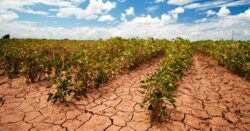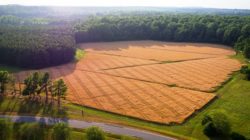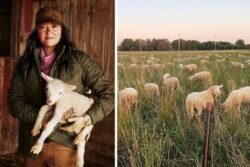Read Time: 8 Minutes Subscribe & Share
The Farm Bill And Us
Hearing about the Farm Bill every five years probably elicits not so much as a yawn from most of us. But unlike much legislative news that we take for granted or ignore because it’s complicated and irrelevant to our daily lives, this bill governs the food we put on our tables and should command our careful attention. Here’s a link to a list of the groups actively pushing for transformative changes in this huge piece of legislation.
The base of the Farm Bill establishes funding and regulations for nutrition, economic development of our agricultural system, and resources for food necessary to communities across the US. (The nutrition regulations were added in 1973). As consumers and voters, we need to make sure our representatives hear from us, or we need to support organizations that are pressuring members of Congress for serious improvements to our food production systems.
Currently, with very few exceptions, in the next five years about 1.5 trillion dollars of taxpayer money will be spread out across twelve Titles within this bill: Commodities, Conservation, Nutrition, Credit (loan programs), Rural Development, Research and Education, Forestry, Energy, Horticulture, Crop Insurance, and Miscellaneous covering outreach, livestock health and labor safety programs. Of those titles, four- Nutrition, Crop Insurance, Farm Commodities and Conservation – receive the most of the allocated funds in this five-year period. Let’s take a look at a few of of the details and developments as the current Farm Bill proposals may well become the most expensive on record.
will be spread out across twelve Titles within this bill: Commodities, Conservation, Nutrition, Credit (loan programs), Rural Development, Research and Education, Forestry, Energy, Horticulture, Crop Insurance, and Miscellaneous covering outreach, livestock health and labor safety programs. Of those titles, four- Nutrition, Crop Insurance, Farm Commodities and Conservation – receive the most of the allocated funds in this five-year period. Let’s take a look at a few of of the details and developments as the current Farm Bill proposals may well become the most expensive on record.
The Nutrition Title
 At first glance, this funding mandate takes up about 75% of the Farm Bill budget, and the SNAP program is a major part of this allocation. Formerly called food stamps, SNAP (Supplemental Nutrition Assistance Program) is too often a target for criticism and cutbacks, subject to the erroneous belief that people who use SNAP are takers instead of workers. The reality is that over 60% of SNAP users have jobs and include members of our military. It provides food for people with disabilities and the elderly. Over 80% of the users have at least one child in the household. Since 2004, this program enabled SNAP users to use their EBT cards (Electronic Benefits Transfer) at certain farmers markets and get double “points” to increase the value of their food purchases. Anecdotally, when I see shoppers using their SNAP benefits at the Farmers Markets I frequent, their bags are filled with fresh produce and local comestibles, and I hear talk about how they are going to prepare what they have purchased. A far cry from a fast food happy meal, and exactly what the program aims for.
At first glance, this funding mandate takes up about 75% of the Farm Bill budget, and the SNAP program is a major part of this allocation. Formerly called food stamps, SNAP (Supplemental Nutrition Assistance Program) is too often a target for criticism and cutbacks, subject to the erroneous belief that people who use SNAP are takers instead of workers. The reality is that over 60% of SNAP users have jobs and include members of our military. It provides food for people with disabilities and the elderly. Over 80% of the users have at least one child in the household. Since 2004, this program enabled SNAP users to use their EBT cards (Electronic Benefits Transfer) at certain farmers markets and get double “points” to increase the value of their food purchases. Anecdotally, when I see shoppers using their SNAP benefits at the Farmers Markets I frequent, their bags are filled with fresh produce and local comestibles, and I hear talk about how they are going to prepare what they have purchased. A far cry from a fast food happy meal, and exactly what the program aims for.
The Crop Insurance Title
Although Crop Insurance took a mere 40 billion dollars over five years, its main beneficiaries deserve a closer look. The theory behind Crop Insurance was borne out of the farming disasters that took place in the early twentieth century, giving farmers and ranchers some protection against crop or livestock failure, as well as a decline in pricing.
took place in the early twentieth century, giving farmers and ranchers some protection against crop or livestock failure, as well as a decline in pricing.
But reading through several farm-oriented news sites that are not associated with agribusiness lobbies, I found that the Crop Insurance Title benefits almost exclusively the largest commodity farms (corn, soy, cotton, wheat, livestock) whose owners generally possess the highest levels of wealth and income. The private insurance companies that charge the premiums and dole out the payments are funded and guaranteed a substantial profit by taxpayers. Small farms, start-up farms, and particularly socially disadvantaged farmers and organic farmers have formidable barriers to accessing the Farm Bill’s crop insurance programs.
The Commodities Title
 Very briefly, this title covers price and income support for the farms and ranches that raise and market widely-produced and traded non-perishable crops, like corn, soybeans, wheat, and rice – as well as dairy and sugar. It also provides some agricultural disaster assistance. It should be noted that there are other agricultural disaster relief sources outside of the provisions provided by this section of the Farm Bill. Very often large farming operations run by agribusinesses essentially profit from the Farm Bill disaster assistance programs under this title, and also grab the benefits from the ad hoc disaster relief programs outside the Farm Bill.
Very briefly, this title covers price and income support for the farms and ranches that raise and market widely-produced and traded non-perishable crops, like corn, soybeans, wheat, and rice – as well as dairy and sugar. It also provides some agricultural disaster assistance. It should be noted that there are other agricultural disaster relief sources outside of the provisions provided by this section of the Farm Bill. Very often large farming operations run by agribusinesses essentially profit from the Farm Bill disaster assistance programs under this title, and also grab the benefits from the ad hoc disaster relief programs outside the Farm Bill.
One of the reforms for the future Farm Bill sought by sustainable farming groups is to force the provisions of the Commodities Title to alter the practices of conventional farms and ranches that have inflicted so much damage to arable land and to our food. In other words, to take advantage of the income and price support offered by the Commodities Title, the horrific practices of CAFOs and the damage that has been done by continual monocrop farming would have to change under new sustainable agriculture rules.
The Conservation Title
A newcomer section of the Farm Bill introduced in 1985 authorizes voluntary programs that help farmers and ranchers implement natural resource conservation efforts on their properties. Such programs allow for improved productivity while simultaneously addressing natural resource and environmental concerns. It includes a voluntary program where highly eroded farmland is removed from production for a decade or longer to repair the soil, and participating farmers are reimbursed for not growing on that land. But in truth, much of the intent is jiggered by successful lobbying by agribusinesses to benefit monocrops, the most famous of which is corn. Few farmers are going to sacrifice their arable acreage for crop rotation when they could be collecting higher subsidies for growing crops instead of a lesser profitable conservation program. In some states, the value of acreage is rated on it suitability to grow corn, called the CSR. The more corn a farm can grow, the greater the various subsidies and the higher price each acre can command for rent or resale to another farmer. So voluntary conservation programs really don’t stand a chance when the remaining farms are practicing the short-sighted mantra Grow Big Or Die. They need to have at least a thousand acres to survive in the dystopian world created by commodity agriculture and supported by many of the policies crafted into previous Farm Bills.
farmers and ranchers implement natural resource conservation efforts on their properties. Such programs allow for improved productivity while simultaneously addressing natural resource and environmental concerns. It includes a voluntary program where highly eroded farmland is removed from production for a decade or longer to repair the soil, and participating farmers are reimbursed for not growing on that land. But in truth, much of the intent is jiggered by successful lobbying by agribusinesses to benefit monocrops, the most famous of which is corn. Few farmers are going to sacrifice their arable acreage for crop rotation when they could be collecting higher subsidies for growing crops instead of a lesser profitable conservation program. In some states, the value of acreage is rated on it suitability to grow corn, called the CSR. The more corn a farm can grow, the greater the various subsidies and the higher price each acre can command for rent or resale to another farmer. So voluntary conservation programs really don’t stand a chance when the remaining farms are practicing the short-sighted mantra Grow Big Or Die. They need to have at least a thousand acres to survive in the dystopian world created by commodity agriculture and supported by many of the policies crafted into previous Farm Bills.
Change The Status Quo
That’s why the new five-year Farm Bill that will be crafted in 2023 is so important to all consumers. A very explicit op-ed piece was written for Civil Eats by Wendy Johnson. She points out that in Iowa her family has owned a substantial conventional farm, which produces a profit growing soy and corn. She has for the last decade turned a very small part of that farm into a certified organic farm, which has revitalized the “natural resources in their  finest forms. The water leaves the farm cleaner than when it arrived, and we have better water-holding capacity when it rains. I have no phosphorus runoff and very little nitrate loss. The trees and shrubs provide nuts, fruits, and habitat for wildlife for a full ecosystem restoration. As floods, droughts, and other extreme weather events get stronger and more frequent every year due to climate change, our perennial system is more resilient. And it can actually help mitigate climate change by sequestering carbon dioxide.” And the profits and the Farm Bill subsidies of the conventional farm pay for it.
finest forms. The water leaves the farm cleaner than when it arrived, and we have better water-holding capacity when it rains. I have no phosphorus runoff and very little nitrate loss. The trees and shrubs provide nuts, fruits, and habitat for wildlife for a full ecosystem restoration. As floods, droughts, and other extreme weather events get stronger and more frequent every year due to climate change, our perennial system is more resilient. And it can actually help mitigate climate change by sequestering carbon dioxide.” And the profits and the Farm Bill subsidies of the conventional farm pay for it.
She states further, “Iowa is one of the most altered ecosystems in the world. Once a rich and diverse landscape filled with prairie grasslands and oak savannas, today it is a grid of corn and soybean fields. The state is home to some of the richest soils in the world, a natural resource that took millennia to form, but those soils are being quickly washed and blown away through stronger and stronger wind and rain events due to climate change; we’re currently losing soil faster than at the height of the 1930s dust bowl.”
She compares it to a mining state not unlike Montana — home to SuperFunds sites left behind by the Anaconda Mines. I visited the Berkeley Pit superfund site, and it was pretty horrifying. Not to mention other nightmares like the amount of chemical fertilizer run-off from the crops and liquid waste from CAFOs that contribute to dead zones in the Gulf of New Mexico.
I like her final paragraphs about the new Farm Bill. There are newer voices at the table, around 150 groups on the list linked in the opening paragraph, and I think Wendy Johnson reflects what we all want.
We need a 2023 Farm Bill that financially rewards farmers who want to grow more diverse crops, plant and preserve trees and forests, graze perennial pastures with ruminants and poultry, and implement the hundreds of other conservation practices proven to keep soil in place, and our water and air clean. And support businesses that build the infrastructure to support diversification. Doing so will make us all more resilient and won’t stop us from being able to “feed the world,” despite common misconceptions.
Simultaneously, we should disincentivize planting conventional corn in back-to-back seasons and tilling whole farm fields multiple times a year. We need to restructure commodity farm programs to be fair to all farmers and inclusive of all crops. Currently, if our corn crops fail, subsidized crop insurance will cover our losses and, in some years, we may even make more money that way than if we had farmed the land. But if we grow anything aside from corn and soybeans, it’s not protected, and we carry the loss on every acre.
The next farm bill should also include an expansion on the existing incentives for small- to mid-scale farms and businesses that produce food for local communities. We also need policies to expand and further support organic agriculture, including technical assistance, agronomists, and local infrastructure to make it easier to transition to organic, and cost share for certification. Incentives and programs that support new and beginning farmers will also be crucial to securing our food system. We need more farmers, not fewer. Current landowners should be incentivized to gradually sell their land to beginning food farmers, rather than to the highest bidder.

Kitchen Detail shares under the radar recipes, explores the art of cooking, the stories behind food, and the tools that bring it all together, while uncovering the social, political, and environmental truths that shape our culinary world.




As a 30 year veteran of USDA (now retired)in the nutrition programs, love that you are posting about the Farm Bill. The Nutrition programs, particularly SNAP, are essential entitlement programs for the nation. No one should go hungry, and all should have adequate resources to feed themselves. And while i know less about growing food, found your comments on crop protection and conservation right on.
Hello Frances,
I am so glat that you wrote this comment as a USDA veteran. Because of its size and its lack of lobbying muscle the Nutrition Title (and thus SNAP) is such an easy target. Where we need to implement drastic changes in the other titles.
Nancy